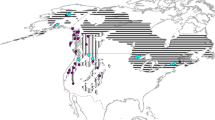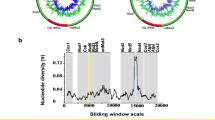Abstract
Comparison of the complete mitochondrial DNA (mtDNA) of the high-Arctic ringed seal (Phoca hispida) and the sub-Arctic harbour (P. vitulina) and grey (Halichoerus grypus) seals shows that they are genetically equidistant from one another. We relate the evolutionary divergence of the three species to expanding glaciation in the Arctic Basin and establish, in conjunction with mtDNA data, a standard reference for calibration of recent divergence events among mammalian taxa. In the present study, we apply the “Phoca standard” to the dating of divergences within the hominid phylogenetic tree. After determining the relative rates of substitution over all mitochondrial protein-coding genes in the different evolutionary lineages, we estimate that humans and chimpanzees diverged from each other 6.1 Mya (95% confidence limits: 5.2–6.9 Mya). The corresponding lower-limit divergence between common chimpanzee,Pan troglodytes, and pygmy chimpanzee,P. paniscus, occurred 3 (2.4–3.6) Mya, and the primary split within theP. troglodytes complex 1.6 (1.3–2.0) Mya. The analyses suggest that the split betweenGorilla andPan/Homo occurred 8.4 (7.3–9.4) Mya. They also suggest thatPongo (orangutan) and the lineage leading to gorillas, chimpanzees, and humans diverged 18.1 (16.5–19.6) Mya. The present analysis is independent of the hominid paleontological record and inferential morphological interpretations and thus is a novel approach to the lower-limit dating of recent divergences.
Similar content being viewed by others
References
Anderson S, Bankier AT, Barrell BG, de Bruijn MHL, Coulson AR, Drouin J, Eperon IC, Nierlich DP, Roe BA, Sanger F, Schreier PH, Smith AJH, Staden R, Young IG (1981) Sequence and organisation of the human mitochondrial genome. Nature 290:475–465
Andrews P (1987) Aspects of hominoid phylogeny. In: Patterson C (ed) Molecules and morphology in evolution: conflict or compromise. Cambridge University Press, Cambridge, GB, pp 23–53
Andrews P, Martin L (1987) Cladistic relationships of extant and fossil hominoids. J Hum Evol 16:101–118
Arnason U, Gullberg A (1994) Relationship of baleen whales established by cytochromeb gene sequence comparison. Nature 367: 726–728
Arnason U, Gullberg A (1996) Cytochromeb nucleotide sequences and the identification of five primary lineages or extant cetaceans. Mol Biol Evol 13:407–417
Arnason U, Johnsson E (1992) The complete mitochondrial sequence of the harbor seal,Phoca vitulina. J Mol Evol 34:493–505
Arnason U, Gullberg A, Johnsson E, Ledje C (1993a) The nucleotide sequence of the mitochondrial DNA molecule of the grey seal,Halichoerus grypus, and a comparison with mitochondrial sequences of other true seals. J Mol Evol 37:323–330
Arnason U, Gullberg A, Widegren B (1993b) Cetacean mitochondrial DNA control region: sequences of all extant baleen whales and two sperm whale species. Mol Biol Evol 10:960–970
Arnason U, Gullberg A, Ledje C, Mouchaty S (1995) A molecular view of pinniped relationships with particular emphasis on the true seals. J Mol Evol 40:78–85
Arnason U, Xu X, Gullberg A (1996) Comparison between the complete mitochondrial DNA sequences of human and the common Chimpanzee. J Mol Evol 42:145–152
Cande S, Kent DVJ (1992) A new geomagnetic polarity time scale for the late Cretaceous and Cenozoic. J Geophys Res 97:13917–13951
Gingerich PD (1984) Primate evolution: evidence from the fossil record. Yearbook Phys Anthropol 27:57–72
Gingerich PD (1986) Temporal scaling of molecular evolution in primates and other mammals. Mol Biol Evol 3:205–221
Godinot M, Mahboubi M (1992) Earliest known Simian primate found in Algeria. Nature 357:324–326
Hill A, Ward S (1988) Origin of the Hominidae, the record of African large hominoid evolution between 14 My and 4 My. Yearbook Phys Anthropol 31:49–83
Horai S, Hayasaka K, Kondo R, Tsugane K, Takahata N (1995) Recent African origin of modern humans revealed by complete sequences of hominoid mitochondrial DNAs. Proc Natl Acad Sci 92:532–536
Irwin DM, Kocher TD, Wilson AC (1991) Evolution of the cytochromeb gene of mammals. J Mol Evol 32:128–144
Janke A, Feldmaier-Fuchs G, Thomas WK, von Haeseler A, Pääbo S (1994) The marsupial mitochondrial genome and the evolution of placental mammals. Genetics 137:243–256
Jansen E, Sjøholm J (1991) Reconstruction of glaciation over the past 6 million years from ice-borne deposits in the Norwegian Sea. Nature 349:600–604
Jukes TH, Cantor CR (1969) Evolution of protein molecules. In: Munro HN (ed) Mammalian protein metabolism. Academic Press, New York, pp 21–132
Kappelman J, Kelley J, Pilbeam D, Sheikh KA, Ward S, Anwar M, Barry JC, Brown B, Hake P, Johnson NM, Raza SM, Shah SMI (1991) The earliest occurrence ofSivapithecus from the middle Miocene Chinji Formation of Pakistan. J Hum Evol 21:61–73
Morin PA, Moore JJ, Chakraborty R, Jin L, Goodall J, Woodruff DS (1994) Kin selection, social structure, gene flow and the evolution of chimpanzees. Science 265:1193–1201
Nei M, Gojobori T (1986) Simple methods for estimating the numbers of synonymous and nonsynonymous nucleotide substitutions. Mol Biol Evol 3:418–426
Pilbeam D (1984) The descent of hominoids and hominids. Sci Am 250(3):60–69
Pilbeam D, Rose MD, Barry JC, Shah SMI (1990) NewSivapithecus humeri from Pakistan and the relationship ofSivapithecus andPongo. Nature 348:237–239
Ruvolo M, Pan D, Zehr S, Golberg T, Disotell TR, von Dormum M (1994) Gene trees and hominoid phylogeny. Proc Natl Acad Sci USA 91:8900–8904
Saitou N, Nei M (1987) The neighbor-joining method—a new method for reconstructing phylogenetic trees. Mol Biol Evol 4:406–425
Shackleton NJ, Backman J, Zimmerman H, Kent DV, Hall MA, Roberts DG, Schnitker D, Baldauf JG, Desprairies A, Homrighausen R, Huddlestun P, Keene JB, Kaltenback AJ, Krumsiek KAO, Morton AC, Murray JW, Westberg-Smith J (1984) Oxygene isotope calibration of the onset of ice-rafting and history of glaciation in the North Atlantic region. Nature 307:620–623
Shackleton NJ, Crowhurst S, Hagelberg T, Pisias NG, Schnitker DA (1995) A new late Neogene time scale: application to Leg 138 Sites. In: Mayer LA, Pisias NG, Janecek T (eds) Ocean drilling program—scientific results 138:73–101
White TD, Suwa G, Asfaw B (1994)Australopithecus ramidus, a new species of early hominid from Aramis, Ethiopia. Nature 371:306–312
Author information
Authors and Affiliations
Additional information
Correspondence to: U. Arnason
Rights and permissions
About this article
Cite this article
Arnason, U., Xu, X., Gullberg, A. et al. The “Phoca standard”: An external molecular reference for calibrating recent evolutionary divergences. J Mol Evol 43, 41–45 (1996). https://doi.org/10.1007/BF02352298
Received:
Accepted:
Issue Date:
DOI: https://doi.org/10.1007/BF02352298




